The Cape Fear Museum of History and Science
The Cape Fear Museum is a history and science museum located in downtown Wilmington, NC. The museum’s mission is to preserve and interpret the history, science, and culture of the Lower Cape Fear region. It has a wide range of exhibits that showcase the area’s rich history and cultural heritage.
The museum’s permanent exhibits include the replica of the skeleton of giant ground sloth, one of the oldest residents of the area. Another permanent exhibit shares the local history of Michael Jordan who began playing basketball at Laney High School in Wilmington, NC. The museum also has a permanent exhibit called “Through the Lens: Photographic Portraits of the Cape Fear Region,” which features photographs that document the history and culture of the area.
The museum also has a number of temporary exhibits that rotate throughout the year and cover a variety of subjects. Some of those temporary exhibits do not travel but go back into storage. Some of those artifacts include antique dolls donated to the museum over the years.
Donated Antique Dolls at Cape Fear Museum
If you walked through the Cape Fear Museum today you will probably only see one antique doll head from the 1860s in a display at the museum. Downstairs, though, lies several other special antique dolls donated to the museum in the past. Once on display at sometime in the past, the dolls are now in storage.
Asking the Collections Manager
When I heard someone in town mention that the Cape Fear Museum had antique dolls, I decided to ask if they would allow someone like myself to see the collection. The museum directed me to Heather Yenco, the collections manager. A Collections Manager works to care for, manage, and preserve the museum’s artifacts collections. This includes overseeing the acquisition, documentation, storage, and display of the collection, as well as ensuring that the collection is accessible to researchers, educators, and the public.
In a very friendly positive response the Ms. Yenco at the Cape Fear Museum sent to me a PDF file she put together showing a list of the dolls held in the museum’s storage. The list included a photograph of each doll, the year someone donated the doll, a brief description, and what was known of the dates and manufacturer, if known at all. It gets better. The she said I could see the dolls in person!
Have you ever been downstairs at the museum? Not every museum, institution, or organization will agree to do this. It could depend on the availability of staff, security of the facility or the items, or other special circumstances. When I arrived at the museum Devon, who works with collections and research, took me to see the dolls. She had already pulled the dolls carefully out of storage and laid them out for viewing before I arrived. What a privilege!
Years the Antique Dolls Came to the Museum
The antique dolls in the collection were donated to the museum at different dates as early as 1966 and on up to 1999. Several of them came to the museum in the 1970s. My biggest hope lay in the opportunity to see antiques I had not yet encountered before and to find new antique doll markings. I think only two of the dolls were not yet old enough to be antiques but would reach the age of 100 years very soon.
The Dolls in the Cape Fear Museum Collection
Let me share with you some of the dolls I got to view at the Cape Fear Museum. (This list is not exhaustive.)
1 – A Doll for a Dollhouse Doll

The first doll is a tiny doll donated back in 1966. The tiny doll made of all bisque was probably once a doll for a small dollhouse doll. Her face is painted and she wears a red ribbon scarf and apron. She is kept in a tiny box for stage.
2 – The Jackie Coogan Kid at the Cape Fear Museum
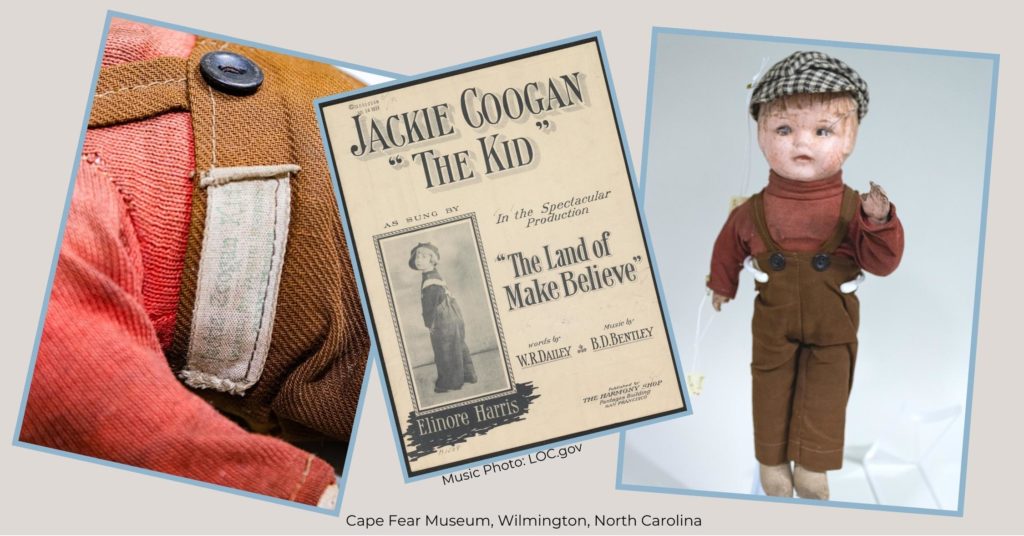
A doll donated in 1971 represents the famous child actor Jackie Coogan who played in the 1921 movie “The Kid” with Charlie Chaplin. Jackie Coogan also played “Oliver Twist” later in 1923. The composition head has lost paint but he has his original outfit and still has the tag on his overalls. The tag reads “Jackie Coogan Kid.” E. I. HORSMAN manufactured the Jackie Coogan Kid dolls. One might find two versions of the Jackie Coogan doll. The 1st one had a generic face mold but the 2nd doll made was meant to truly resemble the actor. This doll was easy to identify especially because of the visible tag. This tag is faded and hard to read, but Jackie Coogan Kid doll tags would read, “Jackie Coogan Kid / Licensed by Jackie Coogan / Patent Pending.”
He is most likely marked, “E I H Co. 19@21” on back of shoulder-plate if the museum ever checks under his turtle neck.
3 – Parian Doll with Blue Glass Eyes

This third doll probably has the secrets to her manufacturer on the back or front of her shoulder plate underneath her dress. Collectors may look at this face and recognize the maker easily. This unglazed bisque doll has deeply molded curly blonde hair, glass blue eyes, pierced ears and a painted closed mouth.
She wears a hand sewn and embroidered dress and has a cloth body but hands made of leather. Dolls like this with curly molded hair made in Germany usually date back to the 1880s and 1890s.
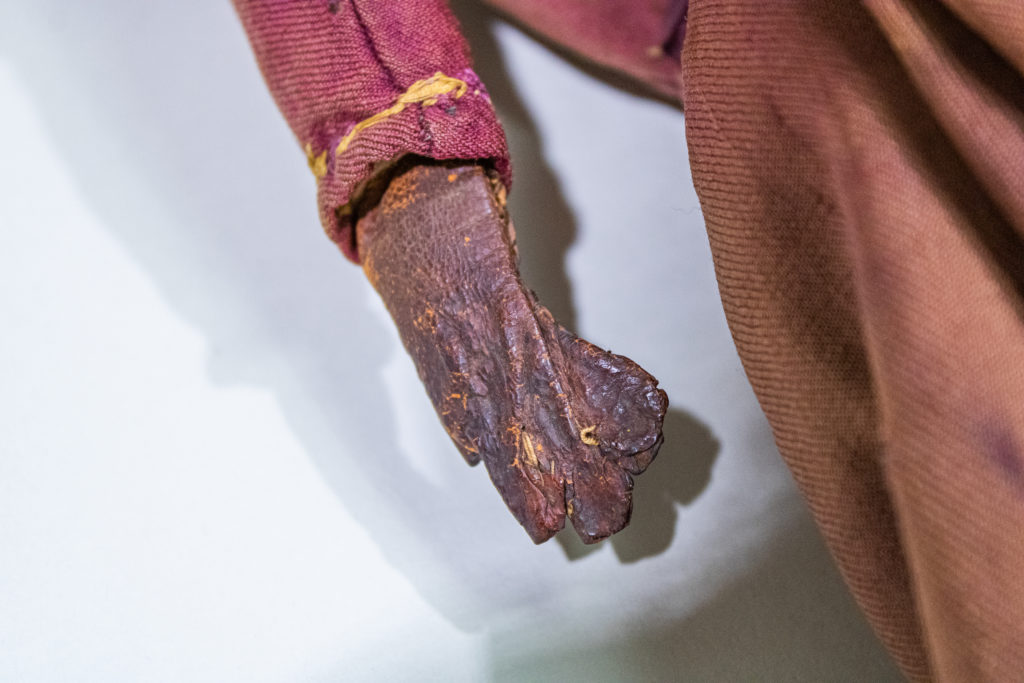
The dark painted line between her lips and her painted eyelashes resemble some dolls made by Alt, Beck and Gottschalck. Simon & Halbig also made similar dolls with molded hair, painted eyelashes, and glass eyes (another possible maker of this doll).
(A great source for comparing similar dolls as this would be the book, “A Pictorial Reference Guide to German Chinas” by Mary Gorham Krombholz.”)
4 – 1860s Wax Head Doll at the Cape Fear Museum
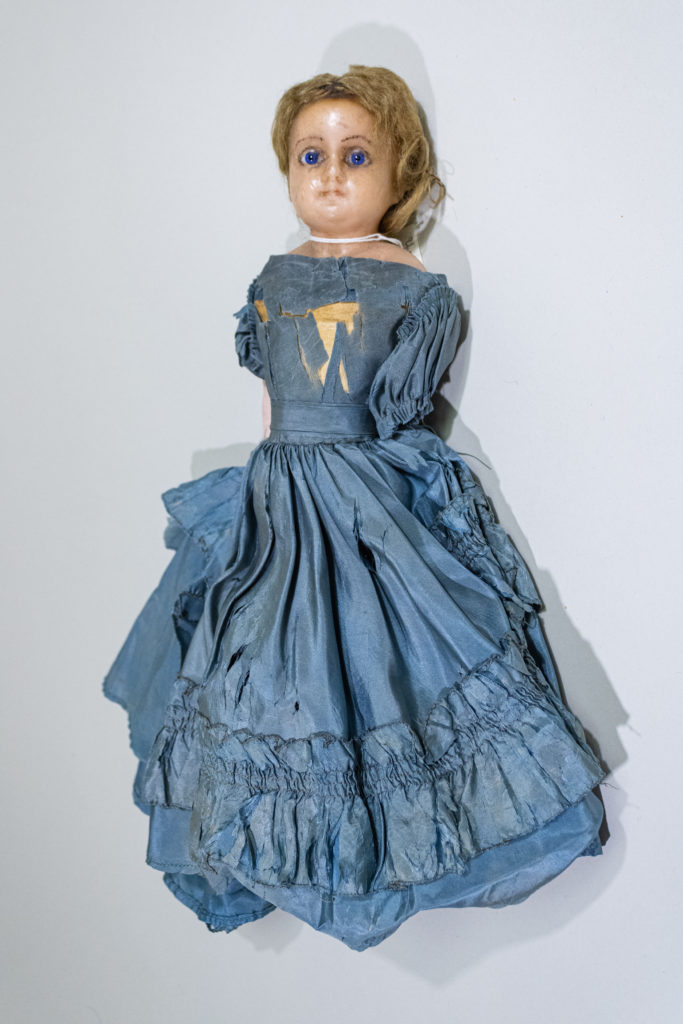
Donated in 1971, the fourth doll fascinates with her long ruffled 1860s Civil War era silk gown that matches her blue glass eyes. This doll has a doll head made of wax, probably was over papier mache or composition. The head sits on a kid leather stuffed doll body with lower arms made of composition (one arm missing.) Under her fabulous blue dress she has a black petticoat, and natural cotton lace trimmed undergarments.
Toy makers started using wax heads in an effort to prevent doll heads from breaking and to give them a more natural appearance compared to the white porcelain of china head dolls. You can find wax head dolls advertised for sale in American newspapers as far back as 1843 in the digital archives at the library of Congress.
5 – Antique Rag Cloth Doll

This antique rag doll came to the museum back in 1971. She has drawn eyes and mouth but her nose protrudes from the face. The museum dates her back to around 1900.
6 – Curly Head All Bisque Doll
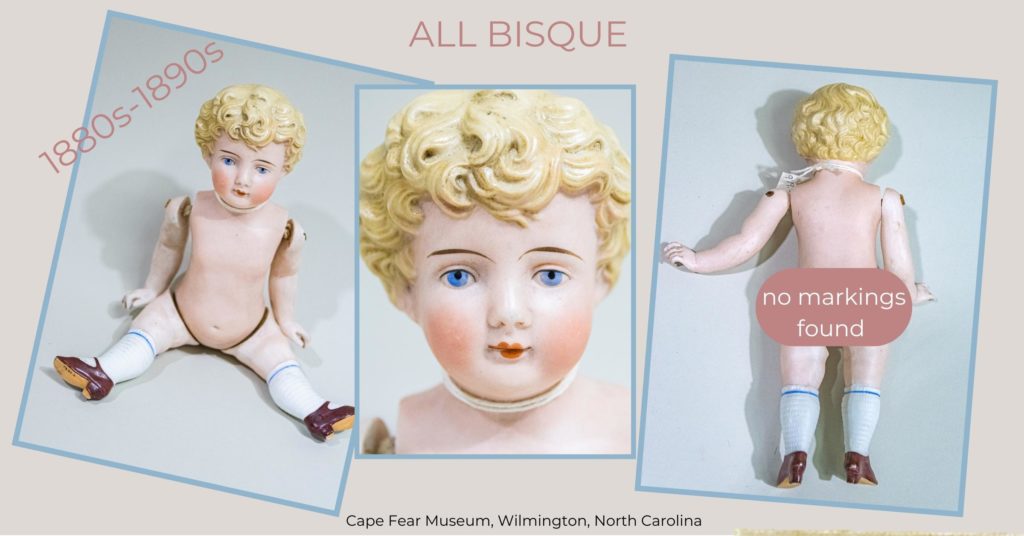
This small jointed all bisque doll was donated in 1979. It has a deeply molded curly childlike hairstyle. The doll has painted blue eyes with not highlights and no painted lashes. It has one stroke painted eyebrows, brown painted mary jane shoes with heels in wonderful condition. The painted socks have horizontal ribs and a blue stripe. The doll had no identification marks at all. The doll resembles German made bisque dolls with similar hairstyles made in the 1880s
7 – Tiny Sleepy Eye All Bisque Doll

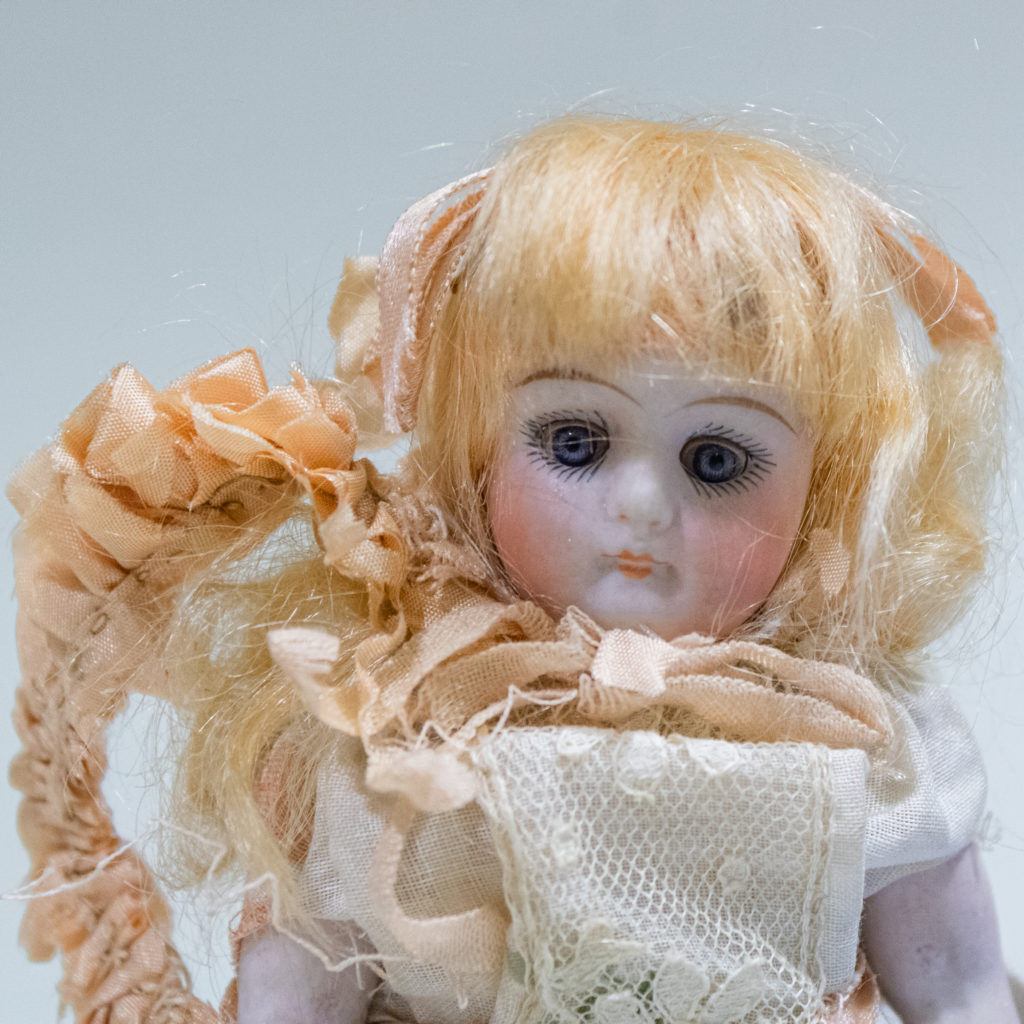
One tiny doll donated in 1974 has an all bisque German made jointed body, sleep eyes, and a mohair wig. She has painted socks and double strap mary jane painted shoes. Because the museum would not remove the dress, she could not be checked for maker marks.
At the museum she lies inside an old Park & Tilford box from New York. Park & Tilford worked as a grocer firm. The paper lace trimmed box could have held anything from candies to cigars originally and most likely is not original to the doll. A similar Park & Tilford box showed up for auction in 2019 on Invaluable with a chess set inside.
A similar German Kestner bisque doll marked 130 and 9 1/2 on her back sold at a Theriault’s auction. That doll also had brown two strapped painted shoes. Theriault labeled it as circa 1910.
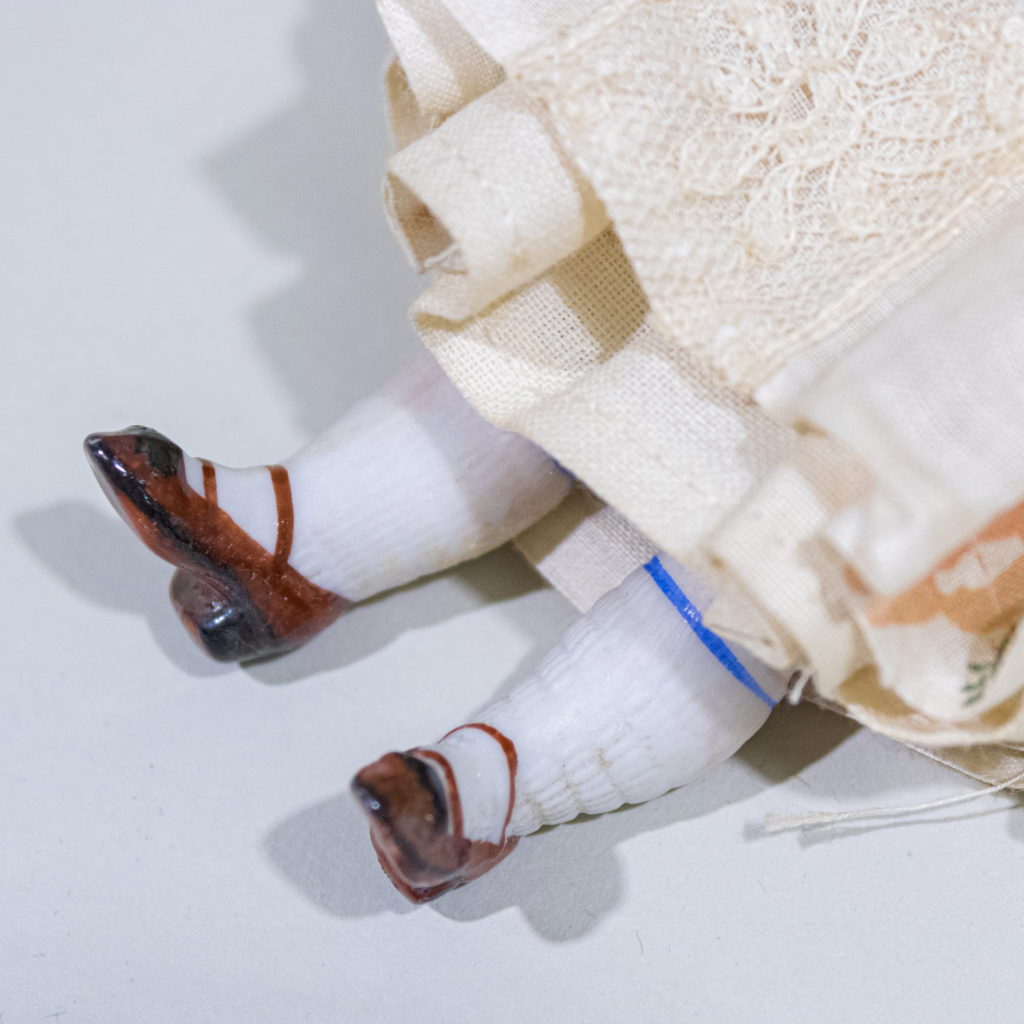
8 – Ethnic Simon & Halbig Doll
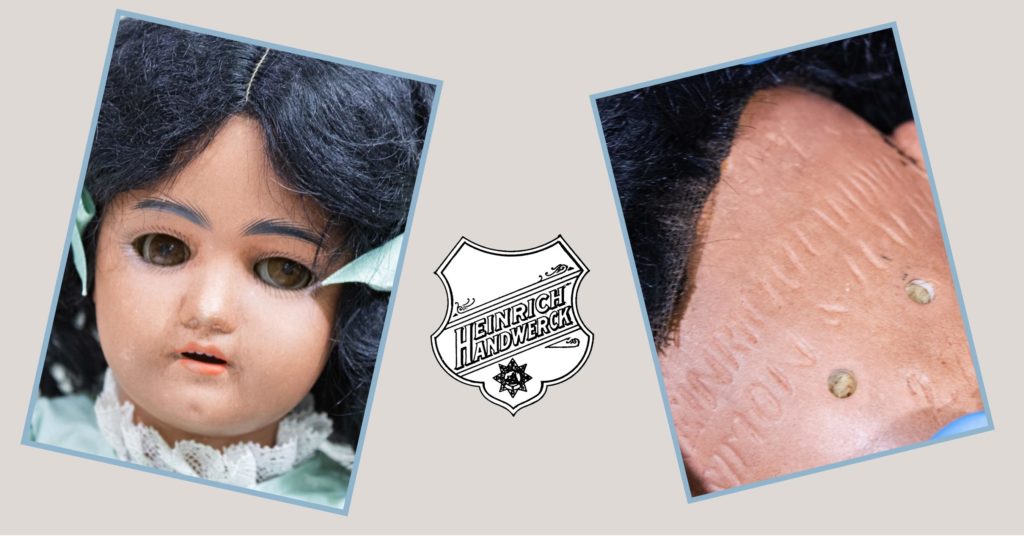
One of the dolls in the collections is a rare German made ethnic doll. Donated to the museum in 1987, she has the marks of Simon & Halbig and Heinrich & Handwerk. Simon & Halbig doll factory made doll heads for the Heinrich & Handwerk doll factory, thus both names appear on the head. The full name of Heinrich Handwerck was not used until after Handwerck died in 1902 which helps date this doll head. When Handwerck died in 1902 Kammer & Reinhardt bought his factory so this doll has a 3 all in one manufacturing history.
She had eyes that close, an open mouth, and her original black mohair wig. The outfit worn on the doll is newer made and not original to the doll. The museum has a note dating her to Christmas of 1909 when she may have been first given as a gift to a child.
9 – Kley & Hahn Walkure Doll

One of the larger dolls at the museum needs restringing. Donated in 1976, this German made jointed doll has the incised initials of K H, the word “Walküre” with the number 250 (indicating the mold for the face). She also has the size number of 4 and 3/4. She had human hair wig, eyes that close, and open mouth with teeth but no pierced ears.
The letters K H stand for Kley and Hahn of Ohrdruf, Germany, who started their manufacturing in 1902 and registered their “Walküre” dolls in 1903. This particular 250 Walkure doll head comes from the J. D. Kestner, Jr. of Waltershausen, Germany who made some doll heads for the Kley & Hahn company. So she is both a Kley & Hahn and a Kestner doll head.
If someone restrings her, the museum also has the outfit that came with her at her donation.
10 – Early German Ball Jointed Doll

This large German made jointed doll donated in 1999 has a bisque socket head, fixed eyes that do not close, an open mouth with teeth, and pierced ears. She wears her original human hair wig with a not often seen braided childlike hairstyle, though a bit topsy on her head from its original position. Her arms lay on the table unstrung from the rest of the jointed doll body.
No Seen Bisque Markings
We could not see a mark on the back of her head, not even in the lower neck where sizes usually exists. Possibly, an incised number sits at the top of the back of her head just under the glued wig. (The museum would not move the wig because forcing a glue doll wig could chip the porcelain/bisque.) Seeing this mold number would help identify the manufacturer of the doll. Yes, even just a number can help trace back the history of antique German made dolls.
8 Ball Jointed Body
Her jointed composition body strung with old cording had 8 individual sliding ball joints at her hips, knees, elbows, and shoulders. She poses for the camera missing her arms that lie on the table unstrung.
A GUESS to her Age
The museum has in their database that she is from the 1920 era but any doll collector might argue that may be from an earlier time. Let me explain why: She does not have markings such as “Germany” on the back of her head. Countries of origin began appearing on doll heads around 1887 and later when Britain started demanding it for imported goods. She has individual ball joints and fixed eyes which may indicate a pre-1900 doll.
The side of her head shows she had a large break that was repaired in her past.
A GUESS to her Manufacturer
In my limited knowledge I might assume she comes from a German manufacturer that made doll heads for the French market. Her jointed body had typical Germany articulation at the knees, thighs, and around the torso. Dolls made for the French market usually had pierced ears. Some better known German manufacturers that made doll heads or dolls for the French market that were Heinrich Handwerck before he died in 1902 and Simon & Halbig. After Heinrich died in 1902 Kammer & Reinhardt bought his factory and his dolls have easy to find and read markings, which this doll does not have.
(Reminder: I am a student of antique dolls using knowledge learned. I am not an expert.)
Her current appearance are easier fixes for experienced doll doctors like cleaning bisque, restringing the arms, or adjusting a wig without doing damage to the bisque. With bisque cleaning, wig adjustment, restring, and an antique doll dress replacement, this pre-1900 antique could make a nice museum display. Restringing would require new cords though.
11 – Simon & Halbig / Kammer & Reinhardt Flirty Eyed Doll

Donated in 1996, this large doll stays at the museum in very good condition! She has fun side glancing eyes patented by the German manufacturer Simon & Halbig. The doll has the marks of both Simon & Halbig and the initials of K&R which stands for Kammer & Reinhardt, another doll manufacturer in Germany. Simon & Halbig made doll heads for Kammer & Reinhardt thus the doll head has both brands incised on the back.
This doll has her original curly mohair wig, molded eyebrows, open slightly smiling mouth, and pierced ears. Her outift and earrings may be replacements but have an antique style.
These side glancing dolls are sometimes called “googly eyed” or “flirty eyed” dolls and highly sought after among antique doll collectors. The eye mechanism works by the use of a metal weight that hangs from the eye fixture. I think it’s too bad she’s not on display with all their fun posing abilities when well strung.
** Interested in seeing what the eye mechanism inside this doll probably looks like? Click here to see my post on Simon & Halbig where you will find a picture of the inside of the doll head of a doll just like or similar to this one. When you see the mechanism, see if you can figure out how it works.
